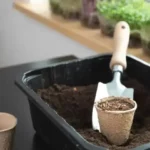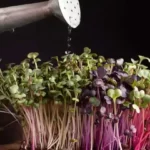Imagine having all the benefits of broccoli and more packed into tiny, vibrant greens. With broccoli microgreens, this is precisely what you’re getting, and you can quickly grow these nutrient powerhouses right on your kitchen counter, on a sunny windowsill, or even outside.
Broccoli microgreens are the young, tender seedlings of the broccoli plant. Despite their small size, research has shown they contain high levels of vitamins, minerals, and antioxidants that can support your overall health, making them a tasty and nutritious superfood.
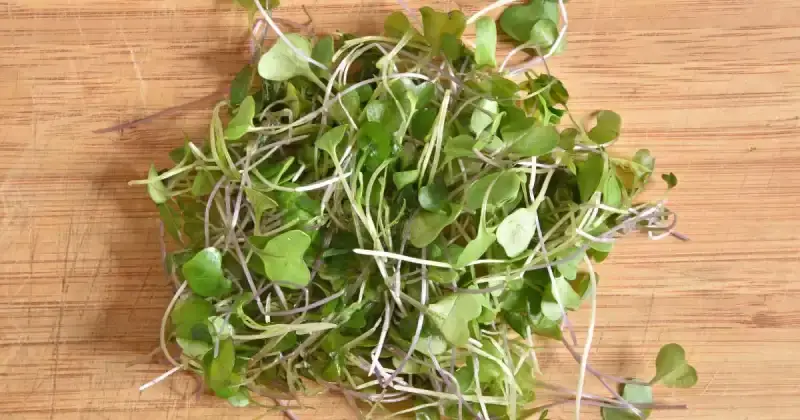
Not only are broccoli microgreens nutritious, but they are also straightforward to cultivate at home and reap their numerous benefits. With a few simple steps and minimal time investment, you can enjoy a constant supply of fresh greens throughout the year.
In this comprehensive guide on broccoli microgreens, we will delve into their health benefits, nutritional information, growth process, and how to effectively incorporate these tiny greens into your diet.
So, let’s start this exciting journey and learn everything you need about broccoli microgreens!
Humble Highlights
- Discover the fantastic nutritional density of broccoli microgreens so you can understand how it compares to mature broccoli grown in the backyard garden or bought at the store.
- Save time by exploring how you can quickly grow this nutritious microgreen in only a few short weeks so you can take advantage of the benefits of this tasty crop.
- Save money by discovering these step-by-step instructions on the equipment and requirements needed to cultivate broccoli microgreens so you can grow them year-round.
What Are Broccoli Microgreens
Broccoli microgreens are the young seedlings of the broccoli plant that are harvested after growing their first true leaves (cotyledons) and then their first true leaves when they are approximately ten days old and 3-4 inches tall. These tiny, vibrant greens are a visually appealing garnish to dishes and an incredibly dense source of nutrients.

Despite their small size, broccoli microgreens contain up to 40 times the amount of nutrients compared to their mature backyard counterparts. These include minerals, essential vitamins, fiber, and protein. Once harvested, broccoli microgreens should be stored in a refrigerator, allowing for a shelf life of 2-3 weeks.
Broccoli microgreens have a mild, slightly spicy flavor, making them versatile for culinary use in various dishes. Eating your broccoli microgreens raw will gain the most nutritional benefits. Add them to salads, sandwiches, soups, and juices, or blend them into smoothies for a healthy boost. 1
Broccoli Microgreens Nutritional Information
If you want to grow your broccoli microgreens at home, you’ve made a good choice, as they are one of the most nutrient-rich microgreens available. Broccoli microgreens contain several vitamins, minerals, and other compounds known to be beneficial for good health, so let’s look at precisely what you can expect to find in these nutrient powerhouses.

The primary vitamins and minerals found in broccoli microgreens are:
- Vitamins A, B, C, E, and K
- Calcium
- Copper
- Iron
- Magnesium
- Phosphorus
- Zinc
Not only are broccoli microgreens packed with these critical nutrients, but they are also high in antioxidants and sulforaphane, which I will talk about later on. 2
So, if you’re looking for a nutrient-dense addition to your diet, consider adding some vibrant and flavorful broccoli microgreens to some of your favorite dishes, or eat it by itself.
Broccoli Microgreens Nutrition vs Broccoli
Since most microgreens possess more nutrients than adult vegetables, it’s understandable why they are a better choice despite the extra cost or preparation time. But how exactly do broccoli microgreens stack up against mature broccoli regarding their nutritional content?

While there is very little information about the nutritional value of broccoli microgreens, the comparison table below has been collated from several sources to provide you with a range of online data.
| Vitamin/Mineral/Compound | Broccoli Microgreen Per 100g (Raw) | Broccoli Per 100g (Raw) |
|---|---|---|
| Vitamin A | 221.8mg | 0.36mg |
| Vitamin C | 51mg | 89.2mg |
| Vitamin E | 24.1mg | 0.78mg |
| Vitamin K | 2.8ug | 102ug |
| Calcium | 88mg | 47mg |
| Copper | 0.09mg | 0.049mg |
| Iron | 0.67mg | 0.73mg |
| Magnesium | 51mg | 21mg |
| Phosphorus | 69 mg | 66mg |
| Zinc | 0.37mg | 0.41mg |
| Glucoraphanin | 4.8 umol/g | Unknown |
| Isothiocyanates (sulforaphane) | 633.11mg | Unknown |
| Calories | 31g | 34g |
| Carbohydrates | 7g | 6.64g |
| Fiber | 0.41g | 2.6g |
| Protein | 2.3g | 2.82g |
Both broccoli and broccoli microgreens have many more vitamins, minerals, and other compounds than I have listed, but the information is difficult to obtain for comparison purposes. 3
When comparing the nutrient content between ordinary broccoli and microgreens using the values in this table, it shows that while microgreens have significantly higher levels of some vitamins and minerals, others are similar or slightly less than standard broccoli.
With that said, one particular study published at the National Center For Biotechnology Information indicated that broccoli microgreens, compared to mature broccoli, not only had a higher nutrient content but contained more nutrients in total.
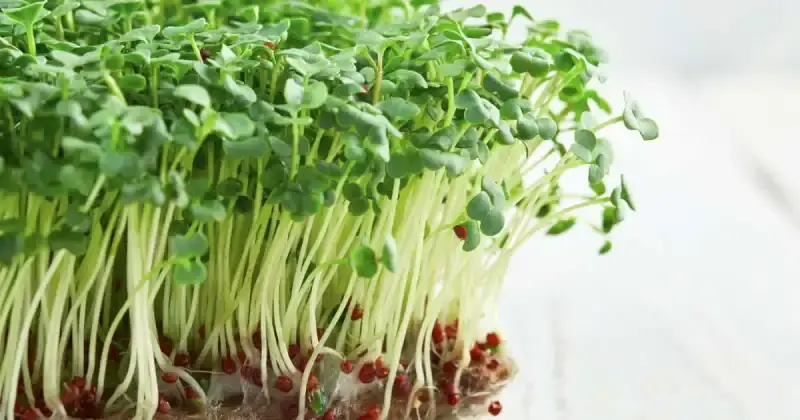
Proper research in controlled conditions has found that different growing mediums and conditions impact the nutritional content of microgreens, so while this table demonstrates their potency to some degree, the information has been aggregated from separate sources and is, therefore, not an accurate comparison.
However, with such impressive amounts of vitamins and minerals, incorporating broccoli microgreens into your diet is an excellent way to boost your overall nutritional health.
Health Benefits Of Eating Broccoli Microgreens
Not only are broccoli microgreens an excellent source of nutrients, but they are also full of phytonutrients, natural compounds found in plants, and have disease-fighting antioxidant properties.

The scientific and health communities are becoming more intrigued by the potential health benefits of eating microgreens, resulting in increased studies and research around how nutrient-dense they are and how different growth methods affect the nutrients they contain.
The early stages of research have demonstrated promising results, making broccoli a powerful ally in the quest for good health. 4
Some potential health benefits of eating broccoli microgreens are:
- Gut health support
- Better brain health
- Reduces the impact of diabetes
- Anti-cancer properties
- Supports cardiovascular health
- Supports lung health
- Anti-aging properties
- Anti-inflammatory
- Improved eye health
- Enhanced immune function
While research on broccoli microgreens is ongoing, you can see the potential health benefits of these tiny powerhouses. In fact, one compound that deserves to be covered in more detail is sulforaphane, which has been linked to many health benefits, especially its potential anti-cancer properties.
Broccoli Microgreens And Sulforaphane
Sulforaphane is a compound found in cruciferous vegetables like broccoli and may be linked to cancer prevention, and you guessed it, broccoli microgreens report high levels of this potent compound.

Sulforaphane is derived from the compound glucoraphanin, which is converted during digestion. Still, it’s essential to know that sulforaphane levels decrease when heated, so eating your broccoli microgreens raw is best to enjoy the full nutritional benefits.
Known for its antioxidant and anti-inflammatory properties, research also suggests that sulforaphane may also help inhibit the growth of cancer cells, potentially reducing the risk of certain types of cancers, including breast, prostate, and colon cancer.
Another health benefit of sulforaphane is its positive impact on gut health. Poor gut health is usually linked to general poor health due to poor absorption of nutrients. Sulfraphane is thought to treat gut inflammation caused by Irritable Bowel Syndrome (IBS), and it has also been observed to help treat the gut bacteria that can cause stomach ulcers. 5
Broccoli microgreens contain much higher levels of sulforaphane than adult broccoli, which is one of the main reasons it’s considered a superfood. Just a handful of microgreens can deliver the same dose of this powerful nutrient as several heads of broccoli.
Are Broccoli Microgreens Easy To Grow
If you’re considering growing broccoli microgreens, you’ll be glad to know they’re relatively easy to grow. Indoor gardening is the perfect solution for those with limited outdoor space or unfavorable weather conditions within their growing region.
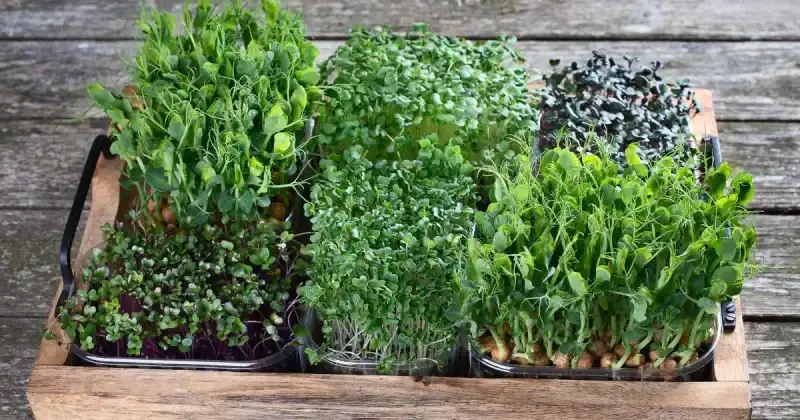
You are good to go if you have essential equipment and an excellent space with plenty of sunlight throughout the day. If you don’t have a suitable area, grow lights and fans can be easily incorporated to simulate ideal growing conditions.
While growing broccoli microgreens are generally straightforward, some common challenges can be overwatering or under-watering and maintaining proper lighting conditions. 6
By staying attentive to these factors and following proper care guidelines, you can enjoy the numerous health benefits of these delicious greens in just a couple of weeks!
How To Grow Broccoli Microgreens
Several methods can be used to grow broccoli microgreens, such as planting in a growing medium such as soil, peat, or coco coir, or hydroponically, where gardeners use water instead of soil.

Most varieties of microgreens can be grown in the same way. However, there are a few differences when it comes to broccoli. One example is that it’s recommended to soak microgreen seeds overnight in water. Still, broccoli microgreen seeds typically don’t require soaking and can be planted immediately into moist soil or your growing medium of choice.
In the following sections, I explain the process I use to grow broccoli microgreens successfully and answer the common questions I often encounter. 7
Are you looking for a good overview of the general microgreen growing process? Hold up for just a second. I found this short video below, which offers simple, step-by-step instructions on how to do just that in as little time as possible.
Can I Use Regular Broccoli Seeds For Microgreens
A common question I often hear is whether you can use regular broccoli seeds for growing broccoli microgreens, and the answer is yes, you can. They are the same, and the growing process differs from achieving healthy microgreens.
This is true not only for broccoli microgreens but also for sowing and cultivating all microgreens. Using regular seeds does have some disadvantages that you should consider, so let’s look at the pros and cons of each.
While using microgreen-specific seeds is generally recommended for optimal results, there are a few advantages to using regular broccoli seeds for growing microgreens:
1. Availability: Regular broccoli seeds can be more readily available and can be found at most garden supply stores, agriculture supply stores, and sometimes even supermarkets.
2. Variety: Regular broccoli seeds may provide a wider variety of cultivars. These seeds may be a good choice if you want to experiment with different flavors, textures, and colors.
3. Cost: Regular broccoli seeds are usually cheaper than specialist microgreen seeds, especially when purchased in large quantities. This could make it more cost-effective if you’re growing on a large scale or just starting and practicing your skills.
4. Flexibility: Buying regular broccoli seeds can serve a dual purpose if you want to grow full-sized broccoli. You can use some for microgreens and set some aside for your garden.
Remember, it’s crucial to ensure that any broccoli seeds you use for microgreens should be untreated, chemical-free, and ideally certified organic to ensure they are safe for consumption.
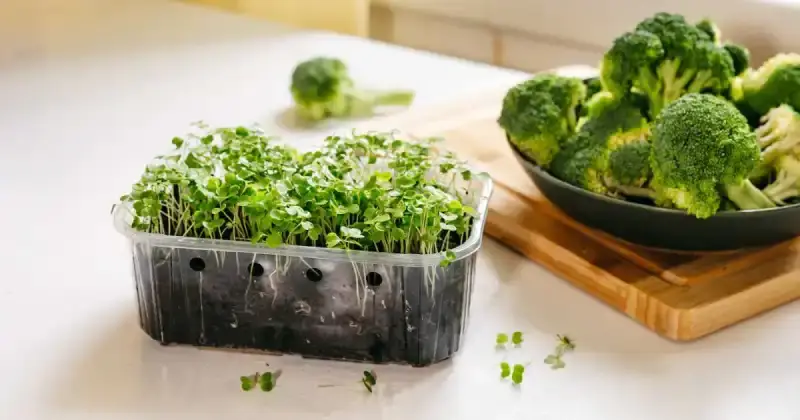
Disadvantages of using regular broccoli seeds for microgreens:
1. Seed Quality: Not all broccoli seeds are created equal. Regular broccoli seeds might not be as vigorous or uniform as those bred explicitly for sprouting and producing microgreens. When seeds are not uniform, some germinate faster than others, leading to inconsistent growth rates within your trays and making the harvest more difficult.
2. Disease Resistance: Regular broccoli seeds may have a different level of disease resistance than those designed for microgreen use. This can increase the risk of diseases like damping off, a fungal infection that can rapidly kill seedlings.
3. Germination Rates: Regular broccoli seeds’ germination rates might be lower than those of microgreens. It means fewer seeds will sprout, which could lead to a less abundant harvest.
4. Cost-effectiveness: Not all regular broccoli seeds will germinate and grow well, so it may not be as cost-effective. Seeds produced for microgreens will more likely deliver a reliable crop.
5. Health Risk: Regular seeds are often treated with fungicides or pesticides, which are harmful if consumed. In contrast, seeds meant for microgreens are usually organic and untreated, making them safer for consumption. Specialized seeds also pose less of a risk for e-coli and Salmonella due to production in sterilized environments, which is extremely important, especially as you typically eat microgreens raw.
I use specialized, organic seeds because I prefer to know precisely how my seeds have been prepared and want to eliminate the potential for food poisoning bacteria. My seeds have an excellent propagation rate and produce incredibly healthy and tasty broccoli microgreens. 8
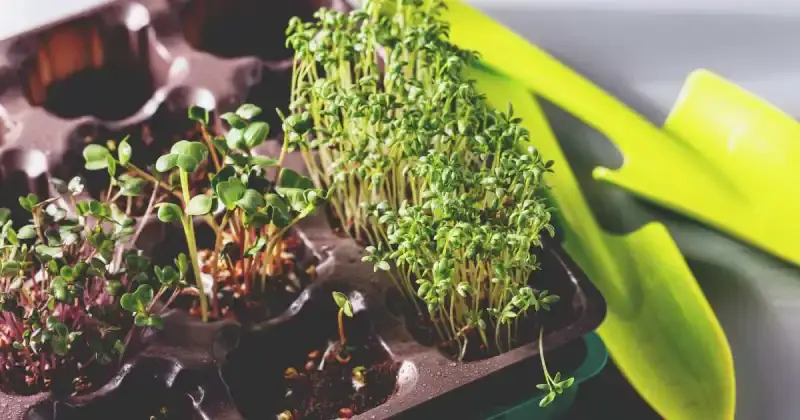
Microgreen Growing Equipment And Requirements
You will need the right equipment if you are ready to transform your space into a mini indoor microgreen garden. Successfully growing microgreens doesn’t have to be expensive, but you need some essential equipment, such as trays or containers, growing media, seeds, and a spray bottle for watering.
What I Use:
- 24-piece seed sprouting tray. This is perfect for growing hydroponically or using a growing medium.
- Riare 2 Piece Coco Coir Brick. A compact coco coir mix which, when soaked, expands to 4 gallons of potting mix.
- Homegrown Heirloom Broccoli Microgreen Seeds. Ensure you source proper broccoli/calabrese microgreen seeds for high sulforaphane content, as some retailers sell RAAB Broccoli Seeds with much lower concentrations of essential nutrients.
- Spray Bottle with misting capability for initial watering of seeds and for misting leaves or roots that are drying out.
The equipment above is what I use for growing broccoli microgreens. I have a well-ventilated area with plenty of natural light. However, I understand that not everyone will have the same setup, so I have included some links to grow lights and fans below.
- Although I haven’t tried them, the GHodec grow lights are reasonably cheap and appear suitable for starting as they are easy to position close to the shoots for maximum light transfer and photosynthesis. Further, they are at the correct temperature to mimic natural sunlight and have an on/off timer.
- A portable high-power fan is essential if your growing environment is hot and humid, as it can lead to the growth of fungus and bacteria. While any fan is suitable if positioned correctly, this portable fan is battery- or USB-operated and can easily be mounted anywhere.
Having the appropriate equipment on hand creates an ideal environment for your broccoli microgreens to thrive and flourish!
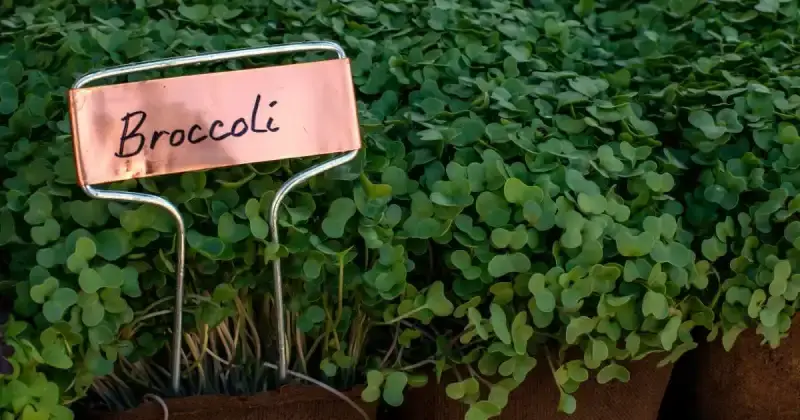
Growing Instructions
While there are many methods to grow microgreens, soil is a popular option among microgrowers, providing them with some of the most consistent success.
The growing trays that I use are suitable for hydroponic growing or using a soil mix. As broccoli microgreen seeds are too small to sit on the hydroponic mesh, I place my soil onto the mesh instead, which prevents the seeds from falling through and is beneficial for bottom watering and drainage.
If you use standard propagation trays, choose ones with drainage holes for easier watering and follow my instructions similarly.
Soil Preparation
To grow broccoli microgreens successfully, you must start with proper soil preparation for your growing trays. Unfortunately, preparing the soil for your broccoli microgreens isn’t as exciting as bungee jumping off a bridge, but ensuring healthy and thriving plants is essential. Here’s how to do it:
Choose a well-draining potting mix that’s rich in organic matter and nutrients. If you have chosen the coconut coir alternative I mentioned above, you will see that it has the perfect texture and is very absorbent.
Spread your soil into the planting tray to a depth of approximately 2.5cm, and use something flat to gently press the ground down to a level surface. Ensure the soil is moist using a spray bottle, but don’t overwater, as pooling water can cause fungus to grow and spread among your crop.

Planting
After properly preparing the soil, it’s time to start planting your broccoli microgreens. Your broccoli seeds will need to be spread evenly and thickly across the soil’s surface but don’t allow them to pile on each other, as they need some space to grow. If your seeds do gather too densely, gently use your finger to spread them more evenly. 9
I use a sieve with holes wide enough for the broccoli seeds, or you can scatter them with a spoon. Once you have spread your seeds over the entire tray, you can move on to watering them.
If you need clarification on the correct seeding density in your tray, always refer to the seed package label for instructions. Sowing microgreen seeds is much like an art. When seeds are spread too lightly, a scraggly and inconsistent crop can result, while too much invites disease and root rot issues to abound.
It may take a few tries if you are new, but once you understand the best ratio, you’ll be rewarded with thick, full, and healthy yields as long as you care for your budding greens throughout their growing process.
Watering
After the initial planting, thoroughly spray your broccoli microgreen seeds without soaking them, as seeds are prone to developing fungus in damp environments. E. coli and Salmonella are other concerns from overwatering in humid environments with stagnant airflow.
Once watered, many microgreen varieties must be kept in darkness for approximately three days (blackout) while propagating. However, you should check them daily to ensure they are damp enough.
I typically sit each tray of microgreens on top of another to cut out any light, which adds some weight and helps improve root strength and structure during this germination stage. Ensure you water your microgreens regularly, as they require consistent moisture to thrive and proliferate.
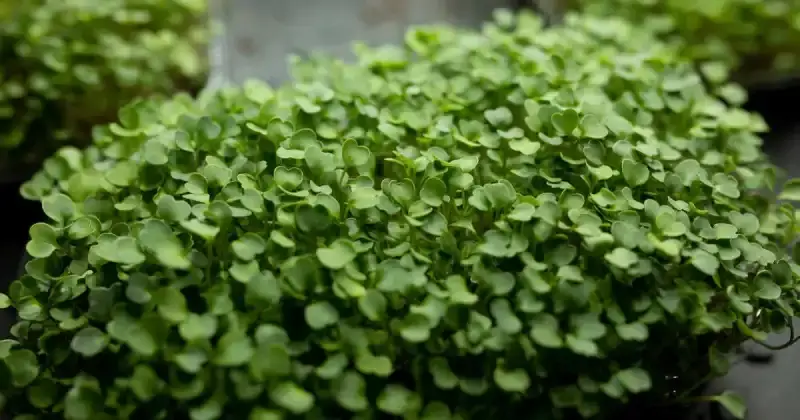
Here are three crucial tips for watering your indoor-grown broccoli microgreens:
1. Use a spray bottle or misting system to distribute water evenly over the growing tray.
2. Avoid over-watering, as it can lead to root rot and attract pests.
3. Water in the morning for optimal nutrient absorption throughout the day.
After Propagation
After your seeds have enjoyed approximately three days of darkness, you should notice a good amount of shoot growth. Don’t be concerned if they look yellow and squashed; the extra weight will have helped the roots become better established. As your greens are placed in sunlight, the leaves will turn a healthy green as photosynthesis begins.
Now that your microgreens no longer need to be covered, place them where they can get around 16 hours of daylight and provide plenty of continual ventilation to prevent mold and fungus from forming. You can also stop top watering with the spray bottle unless the leaves and shoots are excessively drying out.
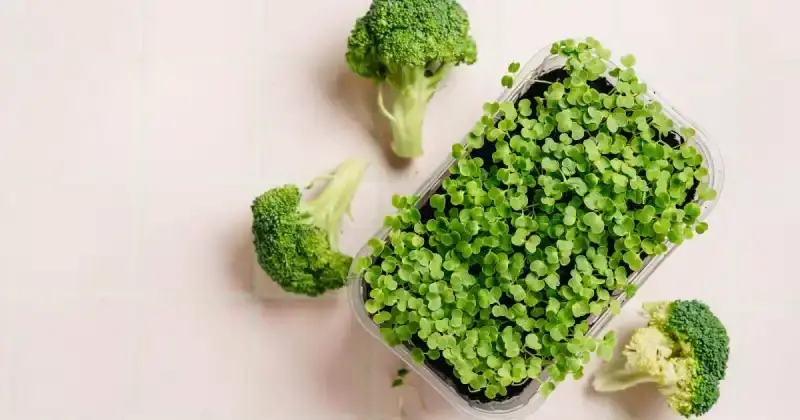
If you are using the mesh trays I use, fill an empty tray with just enough clean water to lift the mesh from the shooting tray and place it over the water, allowing the soil mix to become thoroughly soaked. Lift the mesh back into its original tray, where any excess water will drain through the mesh.
Standard propagation trays with drainage holes can be watered similarly using a suitable water-filled base. Bottom watering ensures the roots have convenient access to water without over-watering the leaves and shoots. Watering may only be necessary once per day. Still, extra watering may be needed in drier regions, so monitoring your growing media and roots for saturation content is best. Remember, your growing medium should feel wet, not saturated.
Harvesting
Your broccoli microgreens will first grow a set of cotyledon leaves (first leaves) before growing their first set of true leaves, usually within 10-14 days. Once their true leaves have appeared, your broccoli microgreens are ready to be harvested.
Harvesting is quite simple and requires a sharp knife, micro pruners, or a pair of scissors. Take a handful of greens from the edge of the tray and cut or slice them approximately 1-2 inches above the soil. Repeat until all greens have been harvested.
It would help to wash your freshly harvested microgreens under running water before storage. I place mine in a colander, but you can allow them to soak in a water bowl. After washing, drain them properly and let them dry by placing them under a fan or on a kitchen towel.
Check out this informative video below that helps troubleshoot common issues with growing microgreens at home and how some easy solutions may be all you need to solve the problem. Growing micros at home can be fun, rewarding, and simple, so long as you follow some guidance that will aid your cultivation operation.
How To Store Broccoli Microgreens After Harvest
Store your freshly harvested broccoli microgreens correctly is crucial for preserving the freshness and prolonging the shelf life of these nutritious greens.
The best containers for storing broccoli microgreens can be sealed tightly, such as glass jars with rubber gaskets or plastic containers with secure lids. Avoid using bags or loosely packed containers as they allow air and moisture to enter, causing the microgreens to wilt quickly. 10
Before storing, remove any excess moisture by gently patting them dry with a paper towel. Place the microgreens in the container, ensuring they are not overcrowded, which can lead to bruising or damage. Store them in the refrigerator at around 40°F (4°C) to maintain their crispness and vibrant color for 12-20 days.
How To Eat Broccoli Microgreens
There are multiple delicious ways to enjoy the nutritional benefits of broccoli microgreens. They can be incorporated into various recipes for added flavor and nutrition. One popular way to prepare broccoli microgreens is by adding them to salads, sandwiches, or wraps for an extra crunch and fresh taste. They can also be blended into smoothies, boosting vitamins and minerals intake.
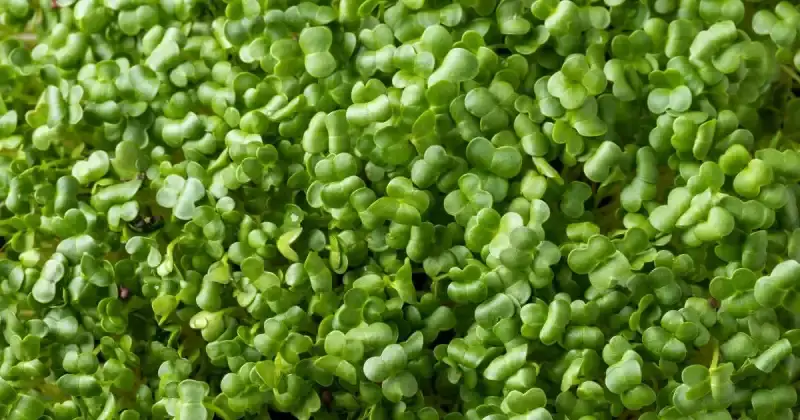
Another option is to sauté them lightly with olive oil and garlic as a side dish or topping for roasted vegetables. Experiment with these versatile greens to spice up your mealtimes and reap their many health benefits!
Differences Between Broccoli Sprouts And Broccoli Microgreens
One key distinction between broccoli sprouts and microgreens is their growth stage. Broccoli sprouts are harvested at an early stage, typically within 4-7 days of germination, when they’ve just developed their first leaves.

On the other hand, microgreens are harvested slightly later, usually around 10-14 days after germination, when they’ve grown larger with more developed leaves. While both broccoli sprouts and microgreens offer a range of nutritional benefits, there are some differences in their nutrient profiles.
Research suggests that broccoli sprouts may contain higher levels of certain beneficial compounds, such as sulforaphane, which I have already explained as having various health benefits, including antioxidant and anti-inflammatory properties.
However, microgreens also pack a powerful nutritional punch with high levels of vitamins C and E, beta-carotene, and other antioxidants. Fortunately, growing broccoli sprouts is relatively easy and can be done indoors using the same seeds used for microgreens. They require minimal space and can be ready to harvest within a week or two. 11
Broccoli sprouts have a slightly more increased risk of bacteria such as e-coli and Salmonella, so ensure to rinse them thoroughly during germination to prevent bacterial contamination and keep a clean and sterile environment.
Both broccoli sprouts and microgreens offer unique nutritional benefits. Incorporating both into your diet can provide a variety of nutrients that support overall health and well-being.
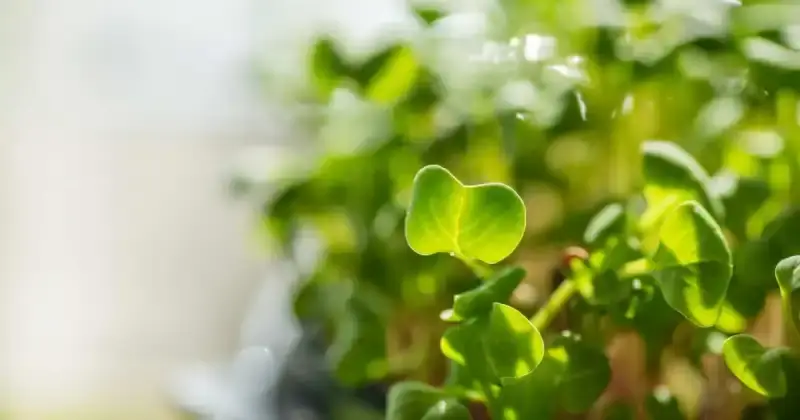
Conclusion
After learning all about the incredible benefits of growing and eating broccoli microgreens, you now understand that these tiny powerhouses are packed with nutrients, can be placed in plenty of your favorite dishes, and offer a wide range of health advantages. Incorporating them into your diet can boost your overall well-being, and enjoy their delicious flavor.
Now that you know how easy it is to grow these little greens, there’s no reason not to start adding them to your meals today. Remember, these mini wonders are like sunshine in every bite, nourishing your body and soul.
Do you currently enjoy growing your broccoli microgreens at home? Take a moment now and let us know the dishes you enjoy adding these delicious and nutritious greens.
SOURCES
- National Library Of Medicine, National Center For Biotechnology Information – Vitamin C Biofortification Of Broccoli Microgreens And Resulting Effects On Nutrient Composition
- ScienceDirect – Antioxidant Properties And Sensory Evaluation Of Microgreens From Commercial And Local Farms
- United States Department Of Agriculture – Baby Broccoli Brings Beneficial Boost
- National Library Of Medicine, National Center For Biotechnology Information – Sprouts And Microgreens – Novel Food Sources For Healthy Diets
- National Library Of Medicine, National Center For Biotechnology Information – Factors Influencing Sulforaphane Content In Broccoli Sprouts And Subsequent Sulforaphane Extraction
- Penn State University, Extension – The ABCs Of Microgreens
- South Dakota State University, Extension – Growing Microgreens At Home
- Oregon State University, Extension – Get Big Flavor From Tiny Microgreens
- Frontiers – Broccoli Microgreens: A Mineral-Rich Crop That Can Diversify Food Systems
- Penn State University, Extension – Growing Microgreens
- National Library Of Medicine, National Center For Biotechnology Information – Sprouts vs. Microgreens As Novel Functional Foods: Variation Of Nutritional And Phytochemical Profiles And Their In Vitro Bioactive Properties


